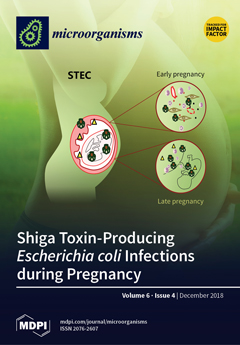In methicillin-sensitive
Staphylococcus aureus (MSSA), the tricarboxylic acid (TCA) cycle is known to negatively regulate production of the major biofilm-matrix exopolysaccharide, PIA/PNAG. However, methicillin-resistant
S. aureus (MRSA) produce a primarily proteinaceous biofilm matrix, and contribution of the TCA-cycle therein remains unclear. Utilizing USA300-JE2
[...] Read more.
In methicillin-sensitive
Staphylococcus aureus (MSSA), the tricarboxylic acid (TCA) cycle is known to negatively regulate production of the major biofilm-matrix exopolysaccharide, PIA/PNAG. However, methicillin-resistant
S. aureus (MRSA) produce a primarily proteinaceous biofilm matrix, and contribution of the TCA-cycle therein remains unclear. Utilizing USA300-JE2 Tn-mutants (NARSA) in genes encoding TCA- and urea cycle enzymes for transduction into a prolific biofilm-forming USA300 strain (UAS391-Ery
s), we studied the contribution of the TCA- and urea cycle and of proteins, eDNA and PIA/PNAG, to the matrix. Genes targeted in the urea cycle encoded argininosuccinate lyase and arginase (
argH::Tn and
rocF::Tn), and in the TCA-cycle encoded succinyl-CoA synthetase, succinate dehydrogenase, aconitase, isocitrate dehydrogenase, fumarate hydratase class II, and citrate synthase II (
sucC::Tn,
sdhA/B::Tn,
acnA::Tn,
icd::Tn,
fumC::Tn and
gltA::Tn). Biofilm formation was significantly decreased under no flow and flow conditions by
argH::Tn,
fumC::Tn
, and
sdhA/B::Tn (range OD
492 0.374−0.667; integrated densities 2.065−4.875) compared to UAS391-Ery
S (OD
492 0.814; integrated density 10.676) (
p ≤ 0.008). Cellular and matrix stains, enzymatic treatment (Proteinase K, DNase I), and reverse-transcriptase PCR-based gene-expression analysis of fibronectin-binding proteins
(fnbA/B) and the staphylococcal accessory regulator
(sarA) on pre-formed UAS391-Ery
s and Tn-mutant biofilms showed: (i) < 1% PIA/PNAG in the proteinaceous/eDNA matrix; (ii) increased proteins under no flow and flow in the matrix of Tn mutant biofilms (on average 50 and 51 (±11)%) compared to UAS391-Ery
s (on average 22 and 25 (±4)%) (
p < 0.001); and (iii) down- and up-regulation of
fnbA/B and
sarA, respectively, in Tn-mutants compared to UAS391-Ery
S (0.62-, 0.57-, and 2.23-fold on average). In conclusion, we show that the biofilm matrix of MRSA-USA300 and the corresponding Tn mutants is PIA/PNAG-independent and are mainly composed of proteins and eDNA. The primary impact of TCA-cycle inactivation was on the protein component of the biofilm matrix of MRSA-USA300.
Full article






